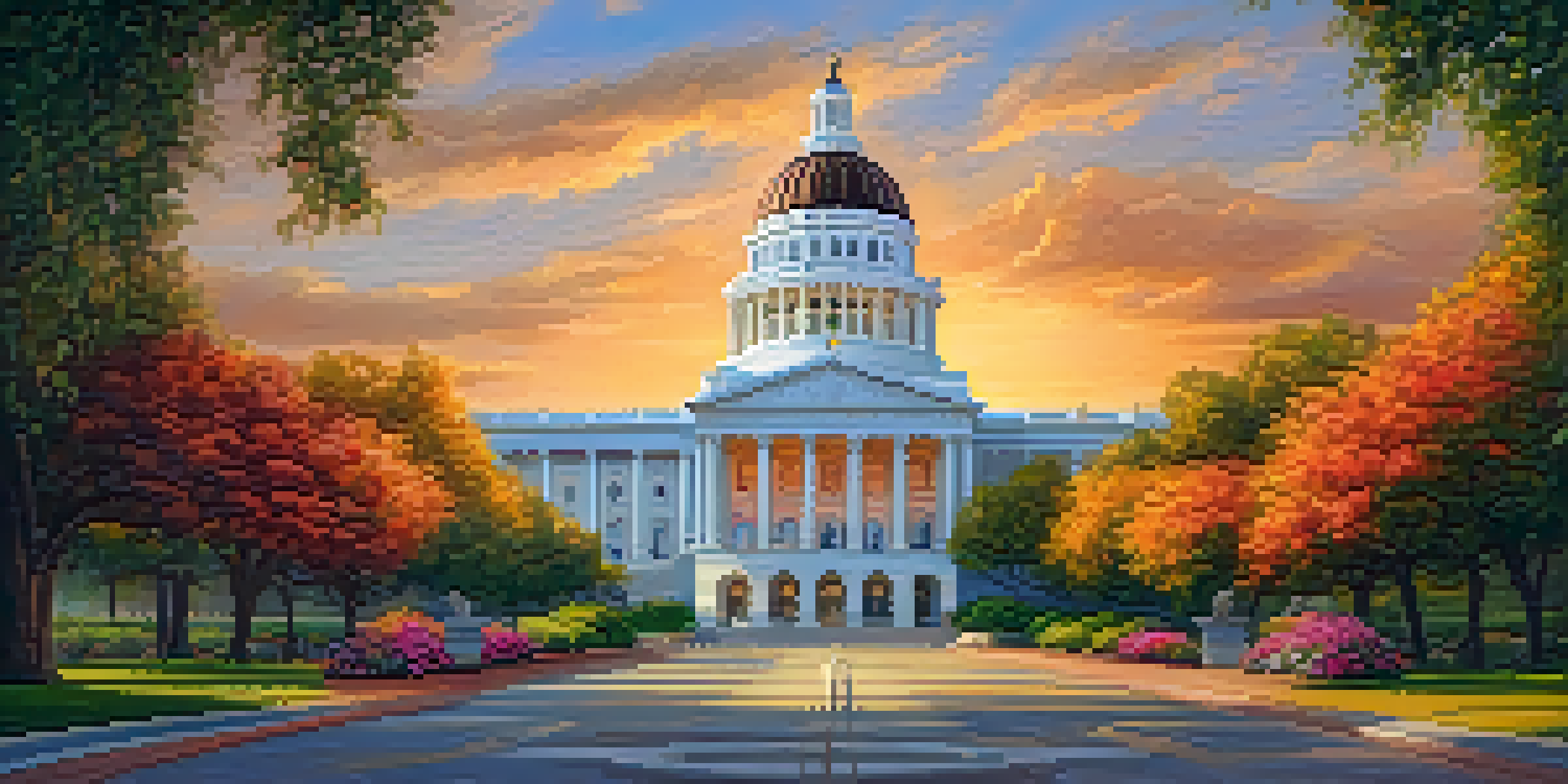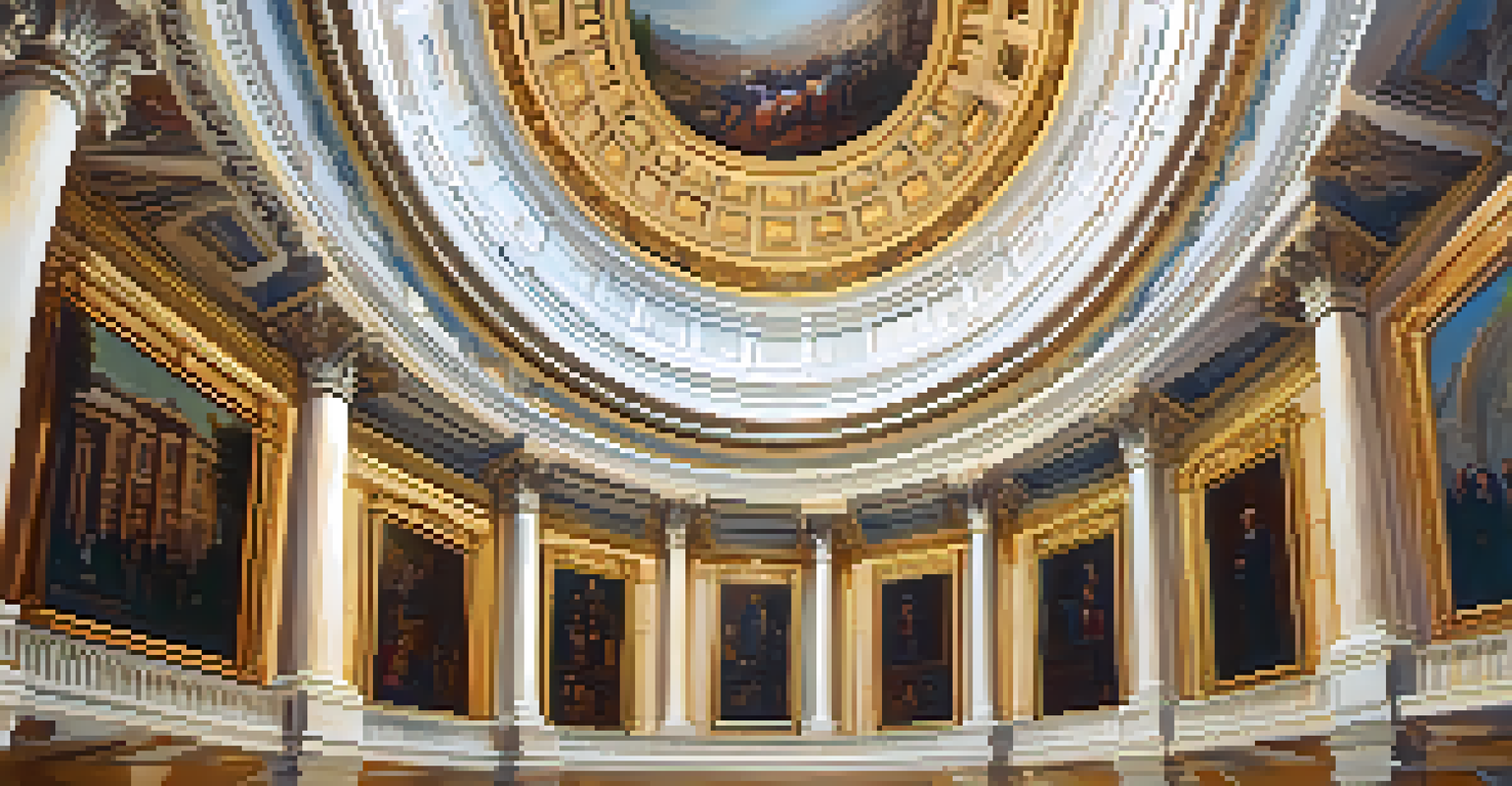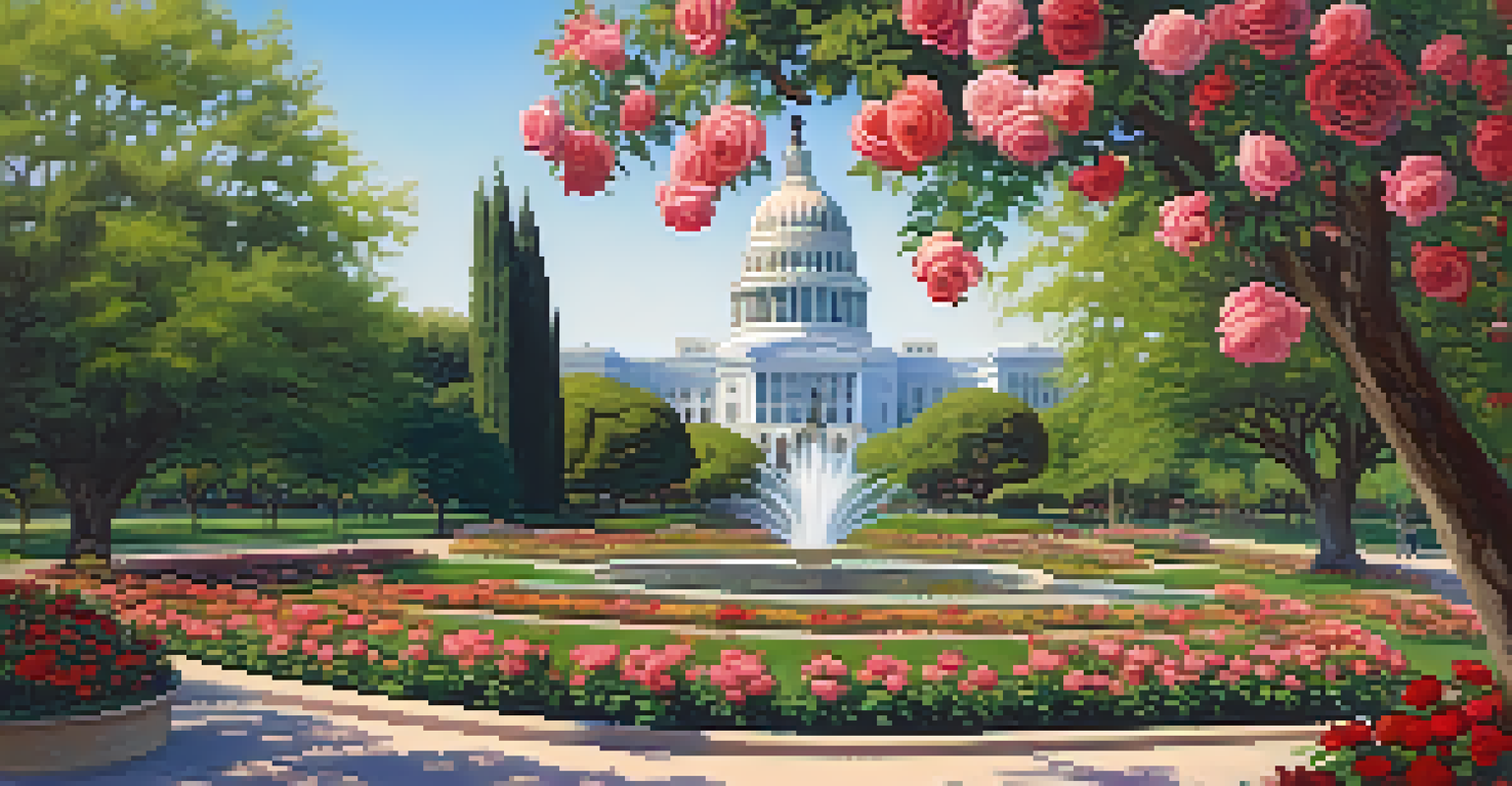The State Capitol: A Historical Gem in Sacramento's Heart

A Brief Overview of the California State Capitol
The California State Capitol, located in the heart of Sacramento, serves as the seat of the state government. Completed in 1874, this stunning building reflects a blend of neoclassical architecture and modern functionality. It stands as a symbol of democracy and governance, hosting both the California State Assembly and the State Senate.
The architecture of a building is a reflection of the culture and values of the people who built it.
Visitors often marvel at its grand dome, which rises majestically above the city skyline, offering a glimpse into the architectural ambitions of the 19th century. The Capitol is not just a functional space; it’s a historical landmark that tells the story of California’s evolution over the years. From its intricate designs to its lush surrounding gardens, every detail invites exploration and admiration.
As you walk through the halls, you can feel the weight of history in the air, where decisions shaping California’s future have been made. The Capitol is more than just a building; it is a repository of the state’s legislative past and a stage for its ongoing political narrative.
Architectural Significance of the Capitol Building
The architectural design of the California State Capitol is a remarkable example of neoclassical style, characterized by its symmetry and grandeur. The building features iconic elements like Corinthian columns and a stunning marble rotunda, which serve as a testament to the design principles of ancient Greece and Rome. This choice of style was intentional, aiming to evoke a sense of permanence and stability.

Inside, the Capitol showcases exquisite artwork, including murals and historical portraits that celebrate California's rich heritage. Each room tells a story, with design elements that reflect the state's diverse culture and history. The attention to detail in the architecture not only enhances the visual appeal but also enriches the visitor experience.
Architectural Beauty of the Capitol
The California State Capitol showcases stunning neoclassical architecture, featuring iconic elements like Corinthian columns and a beautiful marble rotunda.
The Capitol’s design also emphasizes functionality, with spaces that accommodate the needs of lawmakers while welcoming the public. The balance between beauty and utility is a hallmark of great architecture, and the State Capitol embodies this principle perfectly.
Historical Events Held at the State Capitol
Throughout its history, the California State Capitol has been the backdrop for numerous significant events. From pivotal legislative sessions to celebratory gatherings, the Capitol has played a central role in shaping California’s political landscape. One notable event was the signing of landmark legislation that advanced civil rights and environmental protections.
History is not a burden on the memory but an illumination of the soul.
The building also witnessed protests and demonstrations, reflecting the vibrant civic engagement of Californians. These events highlight the Capitol's function as not just a seat of government but a space where voices are heard and change is advocated. Each rally and gathering adds another layer to the Capitol’s rich narrative.
Moreover, the Capitol has hosted many historical figures, including governors, senators, and activists who have left their mark on California. Their legacies continue to inspire current and future generations, making the Capitol a living monument to the state's democratic values.
Exploring the Capitol's Beautiful Grounds and Gardens
The grounds surrounding the California State Capitol are as impressive as the building itself. Spanning over 40 acres, the Capitol Park features beautifully landscaped gardens, trees, and memorials dedicated to California's history. Visitors can enjoy a leisurely stroll through the park, taking in the serene environment that contrasts with the bustle of city life.
One of the highlights of the park is the various themed gardens, including the Rose Garden, which showcases over 1,200 rose bushes. Each garden tells a story, celebrating the diversity of California’s flora and making it a perfect spot for photography or a peaceful retreat. The park is also home to numerous historical monuments that commemorate significant events and figures in California's history.
Historical Significance of Events
The Capitol has hosted pivotal legislative sessions and protests, making it a crucial space for California's political and civic engagement.
These grounds not only serve as a place for relaxation but also as an educational experience, where visitors can learn about the state's past through the monuments and plaques scattered throughout the park. It's a reminder that history is not just found inside buildings but is also alive in the spaces we inhabit.
Visiting the California State Capitol: What to Expect
If you're planning a visit to the California State Capitol, there's plenty to look forward to. Guided tours are available, offering insights into the building's history, architecture, and the legislative process. These tours are a fantastic way to engage with the Capitol's rich narrative and see behind the scenes of California's government.
The Capitol also features a visitor center, where you can find informative exhibits that delve into California's political history. Whether you're a local or a tourist, this resource enhances your understanding of the legislative process and the significance of the Capitol. Don’t forget to check the schedule for special events or sessions that might be happening during your visit.
As you explore, keep an eye out for the various public artworks and historical displays that adorn the hallways. Each piece contributes to the Capitol's story, making every corner of this historic site worth exploring. A visit to the State Capitol is not just an educational experience; it's a journey through time.
The Role of the State Capitol in California's Governance
The California State Capitol is the epicenter of the state's legislative activities. It houses both chambers of the California Legislature, where laws are proposed, debated, and enacted. This dynamic environment reflects the values and priorities of Californians, as elected officials work to address the challenges facing the state.
Each year, the Capitol is where the governor presents the state budget and outlines legislative priorities. This annual ritual underscores the Capitol's critical role in shaping California's financial and social landscape. The discussions and decisions made within these walls resonate throughout the state, impacting millions of lives.
Educational Visitor Experience
Visitors can enjoy guided tours and informative exhibits, providing insights into the Capitol's rich history and the legislative process.
Moreover, the Capitol serves as a venue for public engagement, allowing citizens to voice their opinions on legislation that affects them. This accessibility reinforces the democratic principles that the Capitol embodies, making it a vital part of California's governance and civic life.
Preserving the Legacy of the State Capitol
Preservation efforts for the California State Capitol are crucial to maintaining its historical and cultural significance. Over the years, various restoration projects have aimed to preserve the building's original charm while updating it to meet modern standards. These efforts ensure that future generations can continue to appreciate the Capitol's beauty and historical importance.
The Capitol's preservation is also about safeguarding the stories and memories associated with it. From the legislative debates to the public gatherings, each moment contributes to the Capitol’s legacy. By maintaining the building, we honor the past and ensure a vibrant future for California’s democracy.

Community involvement plays a key role in these preservation efforts, with organizations and individuals advocating for the Capitol's upkeep. Their passion and dedication help keep the spirit of the Capitol alive, reminding us all of the importance of history in shaping our identity as Californians.